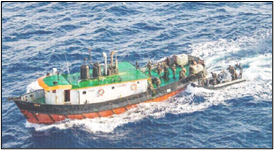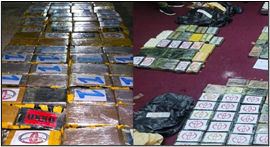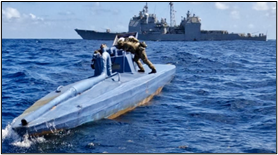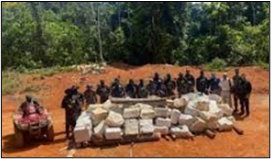Aircraft and narco-submarines are being utilized to smuggle cocaine
WASHINGTON — Today, the U.S. Department of the Treasury’s Office of Foreign Assets Control (OFAC) sanctioned four Guyanese nationals and two Colombian nationals responsible for trafficking tons of cocaine from South America to the United States, Europe, and the Caribbean.
Today’s sanctions target drug traffickers utilizing boats and narco-subs to traffic ton-quantities of cocaine, along with an alleged corrupt Guyanese law enforcement official. The sanctions also target individuals that are operating covert airstrips to traffic drugs via aircraft. For decades, reported corrupt actors have used Guyana as a transshipment point for the movement of drugs from South America to the United States, with Mexican drug cartels also maintaining a presence in the region. International cocaine trafficking remains a serious threat to the United States, as the substantial profits generated from these sales continue to fund and strengthen cartel operations.
“Under President Trump, this administration has achieved the most secure border in modern history. The Treasury Department continues to bring our unique tools and authorities to the fight against cartels and their affiliates. Today’s action is a strong signal that this administration will continue to take the fight to the cartels, regardless of where they are located,” said Deputy Secretary Michael Faulkender. “Treasury will continue to expose the criminal networks that allow for drugs to be trafficked into the United States, and work closely with our law enforcement colleagues and the Government of Guyana to disrupt the cartels wherever they operate.”
Today’s action was taken pursuant to Executive Order (E.O.) 14059, which targets the proliferation of illicit drugs and their means of production. OFAC carried out this investigation in coordination with Homeland Security Investigations (HSI), U.S. Customs and Border Protection (CBP), the Drug Enforcement Administration (DEA), and the U.S. Department of State’s Diplomatic Security Service (DSS).
DRUG TRAFFICKING IN GUYANA
Guyana’s proximity to the Caribbean, as well as alleged corruption along its ports and borders, allows aircraft and maritime vessels, also known as narco-submarines, to transit through its waters undetected. Drug traffickers exploit the rivers and jungles of South America by transporting large quantities of cocaine from Colombia and Venezuela through Guyana and Suriname. Guyana is a close partner of the United States in combating narcotics trafficking; nevertheless, according to a 2025 State Department International Narcotics Control Strategy Report, corruption in Guyana poses a significant obstacle to its efforts to combat drug trafficking.
 In the last few years, Guyana has been the focus of major law U.S. enforcement operations in partnership with Guyanese authorities, resulting in multi-ton seizures of cocaine. In March 2025, a cargo vessel originating in Guyana was discovered by police in the waters of Trinidad and Tobago with approximately 182 kilograms of cocaine.
In the last few years, Guyana has been the focus of major law U.S. enforcement operations in partnership with Guyanese authorities, resulting in multi-ton seizures of cocaine. In March 2025, a cargo vessel originating in Guyana was discovered by police in the waters of Trinidad and Tobago with approximately 182 kilograms of cocaine.
 Cocaine packages stamped with the Toyota logo, a known trademark of the Sinaloa Cartel, were found on-board the cargo vessel. Mexican drug cartels are known for having a presence in Guyana. On February 20, 2025, the State Department identified the Sinaloa Cartel as a Foreign Terrorist Organization (FTO) and as a Specially Designated Global Terrorist (SDGT). Prior to its designation as an FTO, OFAC sanctioned the Sinaloa Cartel on April 15, 2009 pursuant to the Foreign Narcotics Kingpin Designation Act (Kingpin Act) for playing a significant role in international narcotics trafficking. On December 15, 2021, OFAC also designated the Sinaloa Cartel pursuant to E.O. 14059.
Cocaine packages stamped with the Toyota logo, a known trademark of the Sinaloa Cartel, were found on-board the cargo vessel. Mexican drug cartels are known for having a presence in Guyana. On February 20, 2025, the State Department identified the Sinaloa Cartel as a Foreign Terrorist Organization (FTO) and as a Specially Designated Global Terrorist (SDGT). Prior to its designation as an FTO, OFAC sanctioned the Sinaloa Cartel on April 15, 2009 pursuant to the Foreign Narcotics Kingpin Designation Act (Kingpin Act) for playing a significant role in international narcotics trafficking. On December 15, 2021, OFAC also designated the Sinaloa Cartel pursuant to E.O. 14059.
 On March 21, 2024, U.S. and Guyanese law enforcement seized 2,370 kilograms of cocaine in a self-propelled semi-submersible approximately 150 miles off the coast of Guyana.
On March 21, 2024, U.S. and Guyanese law enforcement seized 2,370 kilograms of cocaine in a self-propelled semi-submersible approximately 150 miles off the coast of Guyana.
 In August 2024, Guyanese authorities, with support from DEA and DSS, discovered 4.4 tons of cocaine in a clandestine airfield in the northwest region of Guyana known as Barima-Waini, or Region One, which shares a border with Venezuela. The cocaine was buried in underground bunkers about six feet deep.
In August 2024, Guyanese authorities, with support from DEA and DSS, discovered 4.4 tons of cocaine in a clandestine airfield in the northwest region of Guyana known as Barima-Waini, or Region One, which shares a border with Venezuela. The cocaine was buried in underground bunkers about six feet deep.
CRIMINAL OPERATORS IN GUYANA
 Guyanese nationals Paul Daby Jr. (Daby Jr.) and Randolph Duncan (Duncan) operate the largest drug trafficking organizations in Guyana and rely on maritime vessels and aircraft to conceal and traffic cocaine, while also allegedly bribing Guyanese officials to facilitate their drug trafficking operations. Daby Jr. traffics ton-quantities of cocaine, coordinating the shipment of loads from Colombia and Venezuela via aircraft, and utilizing illegal airstrips in Guyana. Daby Jr. also relies on a network of individuals to conceal and transport cocaine in shipping containers from the ports of Guyana and Suriname. Daby Jr. is also involved in the transporting of illegal gold from Guyana via maritime vessels. Duncan traffics cocaine from Guyana to Africa and the Caribbean, with Europe and the United States as the ultimate destinations.
Guyanese nationals Paul Daby Jr. (Daby Jr.) and Randolph Duncan (Duncan) operate the largest drug trafficking organizations in Guyana and rely on maritime vessels and aircraft to conceal and traffic cocaine, while also allegedly bribing Guyanese officials to facilitate their drug trafficking operations. Daby Jr. traffics ton-quantities of cocaine, coordinating the shipment of loads from Colombia and Venezuela via aircraft, and utilizing illegal airstrips in Guyana. Daby Jr. also relies on a network of individuals to conceal and transport cocaine in shipping containers from the ports of Guyana and Suriname. Daby Jr. is also involved in the transporting of illegal gold from Guyana via maritime vessels. Duncan traffics cocaine from Guyana to Africa and the Caribbean, with Europe and the United States as the ultimate destinations.
Mark Cromwell (Cromwell), a former Guyana Police Force (GPF) officer, is a violent drug trafficker and associate of Daby Jr. Cromwell is wanted by the GPF for his connection to the 2024 abduction of a former Guyanese police officer.
Guyanese national Himnauth Sawh (Sawh), a law enforcement officer of the GPF, has ensured safe passage to Colombian and Venezuelan traffickers through Region One. In September 2024, following the discovery of 4.4 tons of cocaine in Region One by Guyanese officials, Sawh was removed as Divisional Commander of Region One and assigned to the GPF’s Transport Workshop.
Colombian nationals Yeison Andres Sanchez Vallejo (Sanchez) and Manuel Salazar Gutierrez (Salazar) are responsible for overseeing the clandestine airstrips used to transport ton-quantities of cocaine via aircraft from Colombia to Guyana.
OFAC designated Daby Jr., Duncan, Cromwell, Sawh, Sanchez, and Salazar pursuant to E.O. 14059 for having engaged in, or attempted to engage in, activities or transactions that have materially contributed to, or pose a significant risk of materially contributing to, the international proliferation of illicit drugs or their means of production.
SANCTIONS IMPLICATIONS
As a result of today’s action, all property and interests in property of the designated or blocked persons described above that are in the United States or in the possession or control of U.S. persons are blocked and must be reported to OFAC. In addition, any entities that are owned, directly or indirectly, individually or in the aggregate, 50 percent or more by one or more blocked persons are also blocked. Unless authorized by a general or specific license issued by OFAC, or exempt, OFAC’s regulations generally prohibit all transactions by U.S. persons or within (or transiting) the United States that involve any property or interests in property of blocked persons.
Violations of U.S. sanctions may result in the imposition of civil or criminal penalties on U.S. and foreign persons. OFAC may impose civil penalties for sanctions violations on a strict liability basis. OFAC’s Economic Sanctions Enforcement Guidelines provide more information regarding OFAC’s enforcement of U.S. economic sanctions. In addition, financial institutions and other persons may risk exposure to sanctions for engaging in certain transactions or activities involving designated or otherwise blocked persons. The prohibitions include the making of any contribution or provision of funds, goods, or services by, to, or for the benefit of any designated or blocked person, or the receipt of any contribution or provision of funds, goods, or services from any such person.
The power and integrity of OFAC sanctions derive not only from OFAC’s ability to designate and add persons to the Specially Designated Nationals and Blocked Persons List (SDN List), but also from its willingness to remove persons from the SDN List consistent with the law. The ultimate goal of sanctions is not to punish, but to bring about a positive change in behavior. For information concerning the process for seeking removal from an OFAC list, including the SDN List, or to submit a request, please refer to OFAC’s guidance on Filing a Petition for Removal from an OFAC List.
To view the chart on the persons designated today, click here.
For more information on the individuals and entities designated today, click here.
###
